Effects of Wall Properties on Temperature-Control Effectiveness of Heating Section in a Thermosiphon Containing PCM Suspensions
Abstract
1. Introduction
2. Material and Methods
- (1)
- PCM suspension was regarded as incompressible Newtonian fluid and in steady-state, two-dimensional, axisymmetric, and fully developed laminar flow.
- (2)
- Viscous dissipation in the loop flow was neglected.
- (3)
- All other physical properties did not vary with temperature, except that the Boussinesq approximation was used to describe working-fluid density.
- (4)
- PCM particles were evenly distributed in the loop.
- (5)
- Heat-conduction heat transfer inside the pipe wall was axisymmetric. The thermal conductivity of the pipe wall was constant.
- (6)
- There was negligible variation in the density of the PCM particles during the solid–liquid phase transition.
- (7)
- The relative velocity between PCM particles and base fluid was substantially smaller than the total velocity and could be neglected.
- (8)
- The supercooling effect of the PCMs was negligible, i.e., the melting and freezing points of the PCMs were the same.
- (1)
- Outer wall boundary,
- (2)
- Inner wall boundary,
- (3)
- Center of pipe,
3. Numerical Method
4. Results and Discussion
5. Conclusions
Author Contributions
Funding
Conflicts of Interest
Nomenclature
| AR | aspect ratio of rectangular loop, |
| Bip | Biot number of a PCM particle, |
| specific heat | |
| volumetric fraction of PCM particles | |
| g | acceleration due to gravity |
| latent heat of fusion | |
| k | thermal conductivity |
| thermal-conductivity ratio, | |
| thermal-conductivity ratio, | |
| thermal-conductivity ratio, | |
| length of left and right adiabatic sections of lower leg of loop | |
| dimensionless length of left and right adiabatic sections of lower leg of loop, | |
| cooling-section length | |
| dimensionless length of heating section, | |
| heating-section length | |
| dimensionless length of heating section, | |
| rectangular-loop width | |
| dimensionless rectangular-loop width, or | |
| total length of rectangular loop, | |
| correction factor for loop length [29] | |
| dimensionless total length of rectangular loop, or | |
| rectangular-loop height | |
| dimensionless height of rectangular loop, or | |
| elevation of cooling section relative to heating section | |
| dimensionless mean elevation of cooling section relative to heating section, | |
| local heat flux | |
| local dimensionless heat flux, | |
| total convection heat-transfer rate | |
| dimensionless pipe radius, | |
| modified Rayleigh number, | |
| radial coordinate | |
| inner radius of loop pipe | |
| outer radius of loop pipe | |
| PCM particle radius | |
| r | dimensionless radial coordinate, |
| dimensionless particle radius, | |
| axial coordinate | |
| s | dimensionless axial coordinate, |
| modified dimensionless axial coordinate, | |
| Sb* | modified subcooling factor, |
| Ste* | modified Stefan number, |
| pipe-wall thickness () | |
| dimensionless pipe-wall thickness (=) | |
| T | temperature |
| axial velocity | |
| u | dimensionless axial velocity, |
| Greek symbols | |
| α | thermal diffusivity |
| thermal-expansion coefficient | |
| effectiveness of maximal wall temperature control, or | |
| correction factor for loop length, | |
| ν | kinematic viscosity |
| θ | dimensionless temperature, |
| ρ | density |
| base fluid-density ratio, | |
| particle-density ratio, | |
| mean liquid fraction of PCM suspension | |
| liquid-phase volume fraction of PCM particles | |
| latent-heat contribution | |
| Subscripts | |
| b | bulk fluid |
| bf | bulk-to-base-fluid ratio |
| c | cooling section |
| f | base fluid (water) |
| h | heating section |
| i | inner |
| PCM liquid phase | |
| lat | latent heat |
| M | melting point |
| max | maximum |
| p | particle |
| pf | particle-to-base-fluid ratio |
| sen | sensible heat |
| w | pipe wall |
| wf | pipe-wall-to-base-fluid ratio |
| Superscripts | |
| * | ratio of quantities |
| + | dimensional quantity |
References
- Basu, D.N.; Bhattacharyya, S.; Das, P.K. A review of modern advances in analyses and applications of single-phase natural circulation loop in nuclear thermal hydraulics. Nucl. Eng. Des. 2014, 280, 326–348. [Google Scholar] [CrossRef]
- Lokhmanets, I.; Baliga, B.R. Experimental investigation of steady and transient operations of a single-phase closed-loop vertical thermosyphon. Int. J. Therm. Sci. 2019, 145, 105988. [Google Scholar] [CrossRef]
- Tian, C.; Yan, M.; Wang, J.; Cao, X.; Yan, C.; Yu, S. Experimental investigation of flow and heat transfer for natural circulation flow in an inclined narrow rectangular channel. Prog. Nucl. Energy 2017, 98, 266–276. [Google Scholar] [CrossRef]
- Wang, S.; Yang, B.W.; Zhou, Z.; Long, J. Review on thermal-hydraulic characteristics of nuclear reactors under ocean conditions. Nucl. Sci. Eng. 2019, 193, 14–32. [Google Scholar] [CrossRef]
- Ebeling, J.C.; Luo, X.; Kabelac, S.; Luckmann, S.; Kruse, H. Dynamic simulation and experimental validation of a two-phase closed thermosyphon for geothermal application. Propuls. Power Res. 2017, 6, 107–116. [Google Scholar] [CrossRef]
- Celik, S.; Ekren, O. Two-phase refrigerant flow in the evaporator of a stirling cooling system with a thermosyphon loop. Exp. Heat Transf. 2019, 1–13. [Google Scholar] [CrossRef]
- Lamaison, N.; Ong, C.L.; Marcinichen, J.B.; Thome, J.R. Two-phase mini-thermosyphon electronics cooling: dynamic modeling, experimental validation and application to 2U servers. Appl. Therm. Eng. 2017, 110, 481–494. [Google Scholar] [CrossRef]
- Krishnan, V.; Sharma, M.; Pilkhwal, D.; Saha, D.; Sinha, R. A comparative study of single-phase, two-phase, and supercritical natural circulation in a rectangular loop. J. Eng. Gas Turbines Power 2010, 132, 102913. [Google Scholar] [CrossRef]
- Delgado, M.; Lázaro, A.; Mazo, J.; Zalba, B. Review on phase change material emulsions and microencapsulated phase change material slurries: materials, heat transfer studies and applications. Renew. Sustain. Energy Rev. 2012, 16, 253–273. [Google Scholar] [CrossRef]
- Buschmann, M.H. Nanofluids in thermosyphons and heat pipes: overview of recent experiments and modelling approaches. Int. J. Therm. Sci. 2013, 72, 1–17. [Google Scholar] [CrossRef]
- Cho, H.J.; Preston, D.J.; Zhu, Y.; Wang, E.N. Nanoengineered materials for liquid–vapour phase-change heat transfer. Nat. Rev. Mater. 2017, 2, 16092. [Google Scholar] [CrossRef]
- Liu, Z.; Preston, D.J. Enhanced Condensation for Improved Energy Efficiency. Joule 2019, 3, 1180–1189. [Google Scholar] [CrossRef]
- Srimuang, W.; Amatachaya, P. A review of the applications of heat pipe heat exchangers for heat recovery. Renew. Sust. Energ. Rev. 2012, 16, 4303–4315. [Google Scholar] [CrossRef]
- Barber, J.; Brutin, D.; Tadrist, L. A review on boiling heat transfer enhancement with nanofluids. Nanoscale Res. Lett. 2011, 6, 280. [Google Scholar] [CrossRef] [PubMed]
- Zalba, B.; Marin, J.; Cabeza, L.F.; Mehling, H. Review on thermal energy storage with phase change: materials, heat transfer analysis and applications. Appl. Therm. Eng. 2003, 23, 251–283. [Google Scholar] [CrossRef]
- Khan, Z.; Khan, Z.; Ghafoor, A. A review of performance enhancement of PCM based latent heat storage system within the context of materials, thermal stability and compatibility. Energy Convers. Manag. 2016, 115, 132–158. [Google Scholar] [CrossRef]
- Attinger, D.; Frankiewicz, C.; Betz, A.R.; Schutzius, T.M.; Ganguly, R.; Das, A.; Kim, C.J.; Megaridis, C.M. Surface engineering for phase change heat transfer: A review. MRS Energy Sustain. 2014, 1–40. [Google Scholar] [CrossRef]
- Giro-Paloma, J.; Alkan, C.; Chimenos, J.; Fernández, A. Comparison of microencapsulated phase change materials prepared at laboratory containing the same core and different shell material. Appl. Sci. 2017, 7, 723. [Google Scholar] [CrossRef]
- Yang, L.; Liu, S.; Zheng, H. A comprehensive review of hydrodynamic mechanisms and heat transfer characteristics for microencapsulated phase change slurry (MPCS) in circular tube. Renew. Sustain. Energy Rev. 2019, 114, 109312. [Google Scholar] [CrossRef]
- Peng, G.; Dou, G.; Hu, Y.; Sun, Y.; Chen, Z. Phase change material (PCM) microcapsules for thermal energy storage. Adv. Polym. Technol. 2020, 2020, 1–20. [Google Scholar] [CrossRef]
- Zhu, C.; Lin, Y.; Fang, G. Preparation and thermal properties of microencapsulated stearyl alcohol with silicon dioxide shell as thermal energy storage materials. Appl. Therm. Eng. 2020, 169, 114943. [Google Scholar] [CrossRef]
- Zhang, X.; Wu, J.Y.; Niu, J. PCM-in-water emulsion for solar thermal applications: the effects of emulsifiers and emulsification conditions on thermal performance, stability and rheology characteristics. Sol. Energy Mater. Sol. Cells 2016, 147, 211–224. [Google Scholar] [CrossRef]
- Cabaleiro, D.; Agresti, F.; Barison, S.; Marcos, M.A.; Prado, J.I.; Rossi, S.; Bobbo, S.; Fedele, L. Development of paraffinic phase change material nanoemulsions for thermal energy storage and transport in low-temperature applications. Appl. Therm. Eng. 2019, 159, 113868. [Google Scholar] [CrossRef]
- Dammel, F.; Stephan, P. Heat transfer to suspensions of microencapsulated phase change material flowing through minichannels. J. Heat Transf. 2012, 134, 020907. [Google Scholar] [CrossRef]
- Ho, C.J.; Lee, C.Y.; Yamada, M. Experiments on laminar cooling characteristics of a phase change nanofluid flow through an iso-flux heated circular tube. Int. J. Heat Mass Transf. 2018, 118, 1307–1315. [Google Scholar] [CrossRef]
- Ho, C.J.; Chiu, S.Y.; Lin, J.F. Heat transfer characteristics of a rectangular natural circulation loop containing solid-liquid phase-change material suspensions. Int. J. Numer. Methods Heat Fluid Flow 2005, 15, 441–461. [Google Scholar] [CrossRef]
- Ho, C.J.; Chen, C.; Lai, C.M. The effects of geometric parameters on the thermal performance of a rectangular natural circulation loop containing PCM suspensions. Numer. Heat Transf. A: Appl. 2016, 70, 1313–1329. [Google Scholar] [CrossRef]
- Ho, C.J.; Wang, Z.C.; Chen, R.H.; Lai, C.M. Conjugate Heat Transfer Analysis of PCM Suspensions in a Circular Tube Under External Cooling Convection: Wall Conduction Effects. Appl. Sci. 2020, 10, 2034. [Google Scholar] [CrossRef]
- Huang, B.J.; Zelaya, R. Heat transfer behavior of a rectangular thermosyphon loop. J. Heat Transf. 1988, 110, 487–493. [Google Scholar] [CrossRef]
- Ho, C.J. A continuum model for transport phenomena in convective flow of solid–liquid phase change material suspensions. Appl. Math. Model. 2005, 29, 805–817. [Google Scholar] [CrossRef]
- Charunyakorn, P.; Sengupta, S.; Roy, S. Forced convection heat transfer in microencapsulated phase change material slurries: flow in circular ducts. Int. J. Heat Mass Transf. 1991, 34, 819–833. [Google Scholar] [CrossRef]
- Leonard, B.P. A stable and accurate convective modelling procedure based on quadratic upstream interpolation. Comput. Methods Appl. Mech. Eng. 1979, 19, 59–98. [Google Scholar] [CrossRef]
- Metrol, A.; Greif, R.; Zvirin, Y. Two-dimensional study of heat transfer and fluid flow in a natural circulation loop. ASME J. Heat Transf. 1982, 104, 508–514. [Google Scholar] [CrossRef]
- Goel, M.; Roy, S.K.; Sengupta, S. Laminar forced conduction heat transfer in micro-capsulated phase change material suspensions. Int. J. Heat Mass Transf. 1994, 37, 593–604. [Google Scholar] [CrossRef]
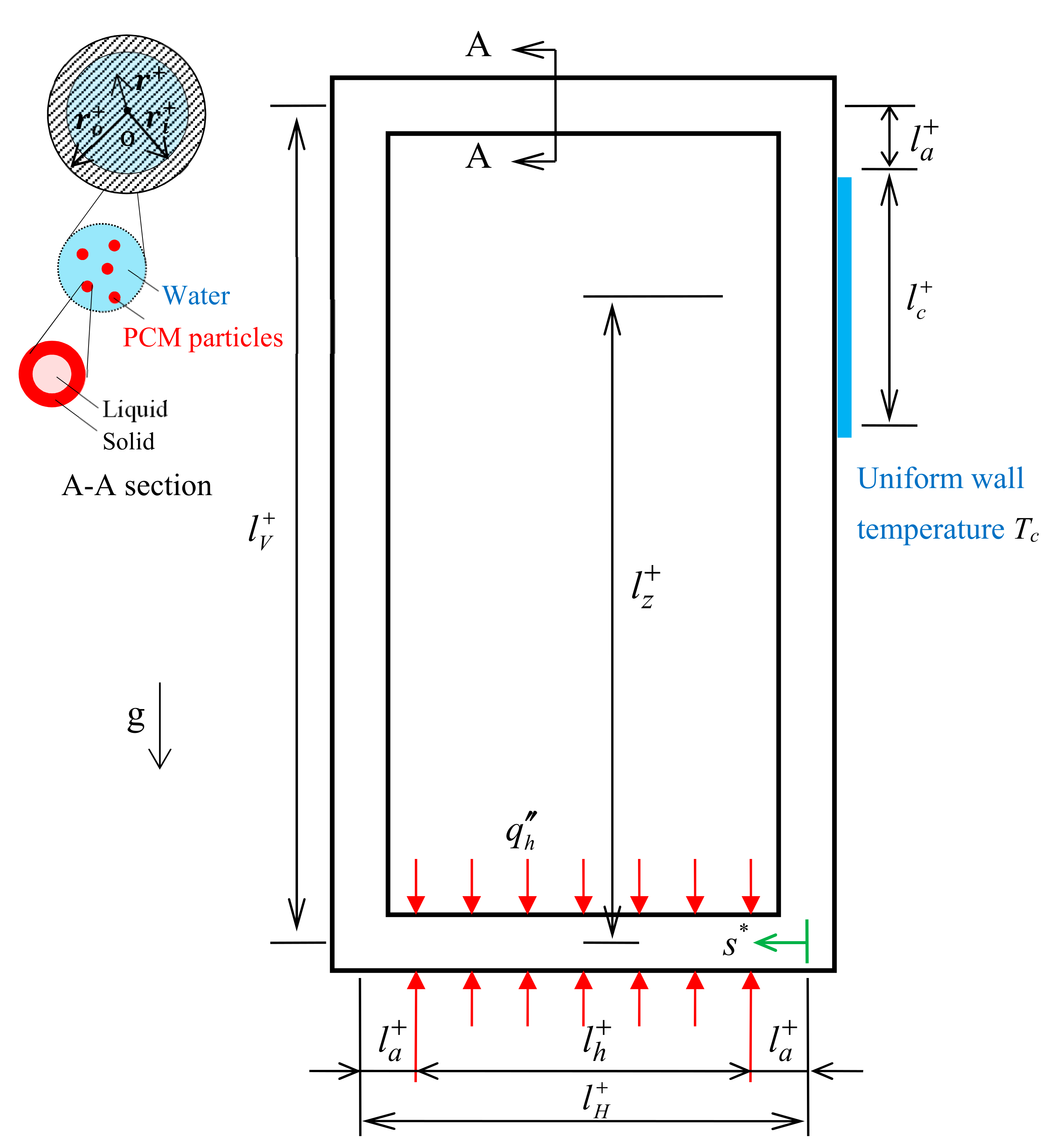


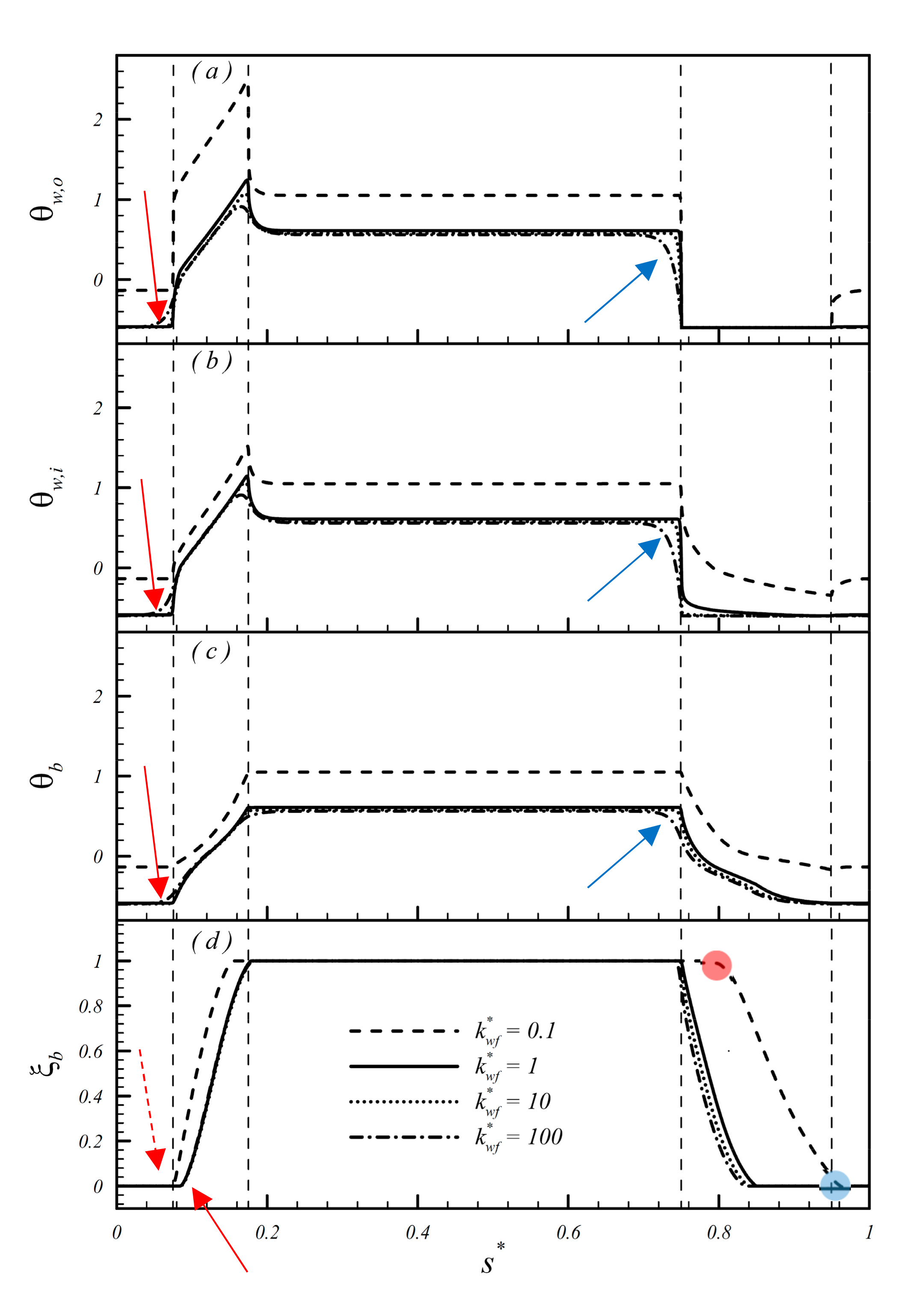
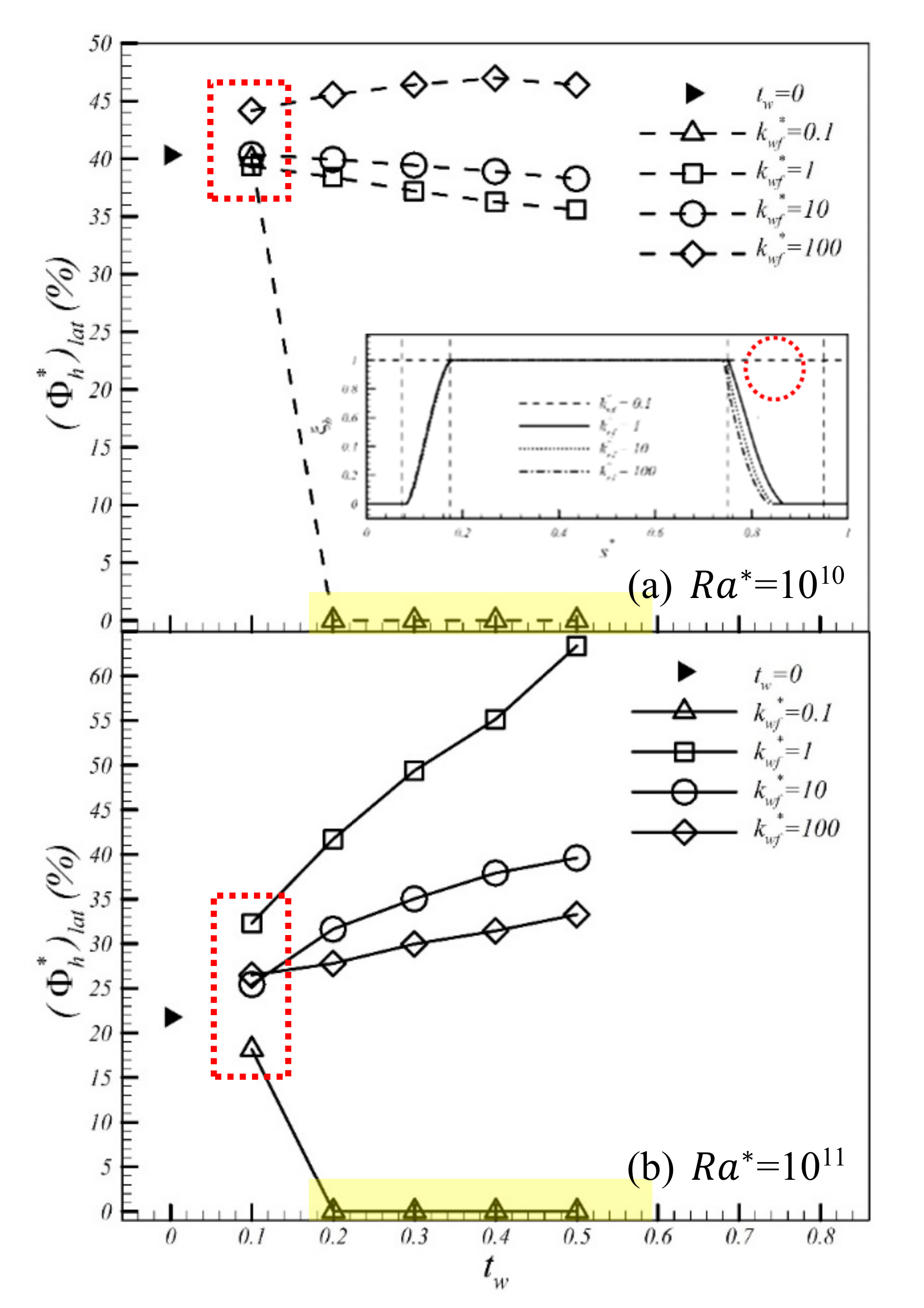
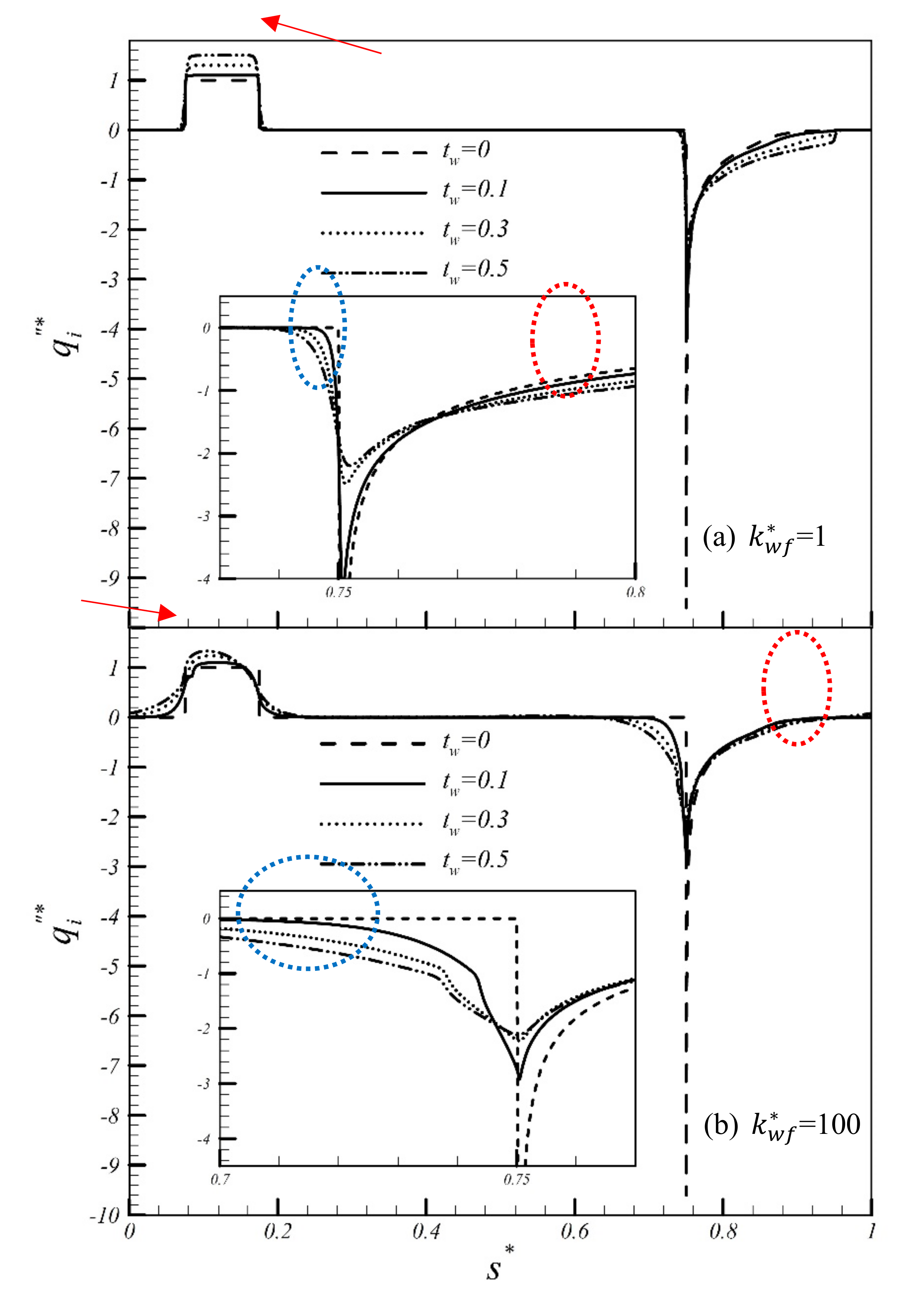
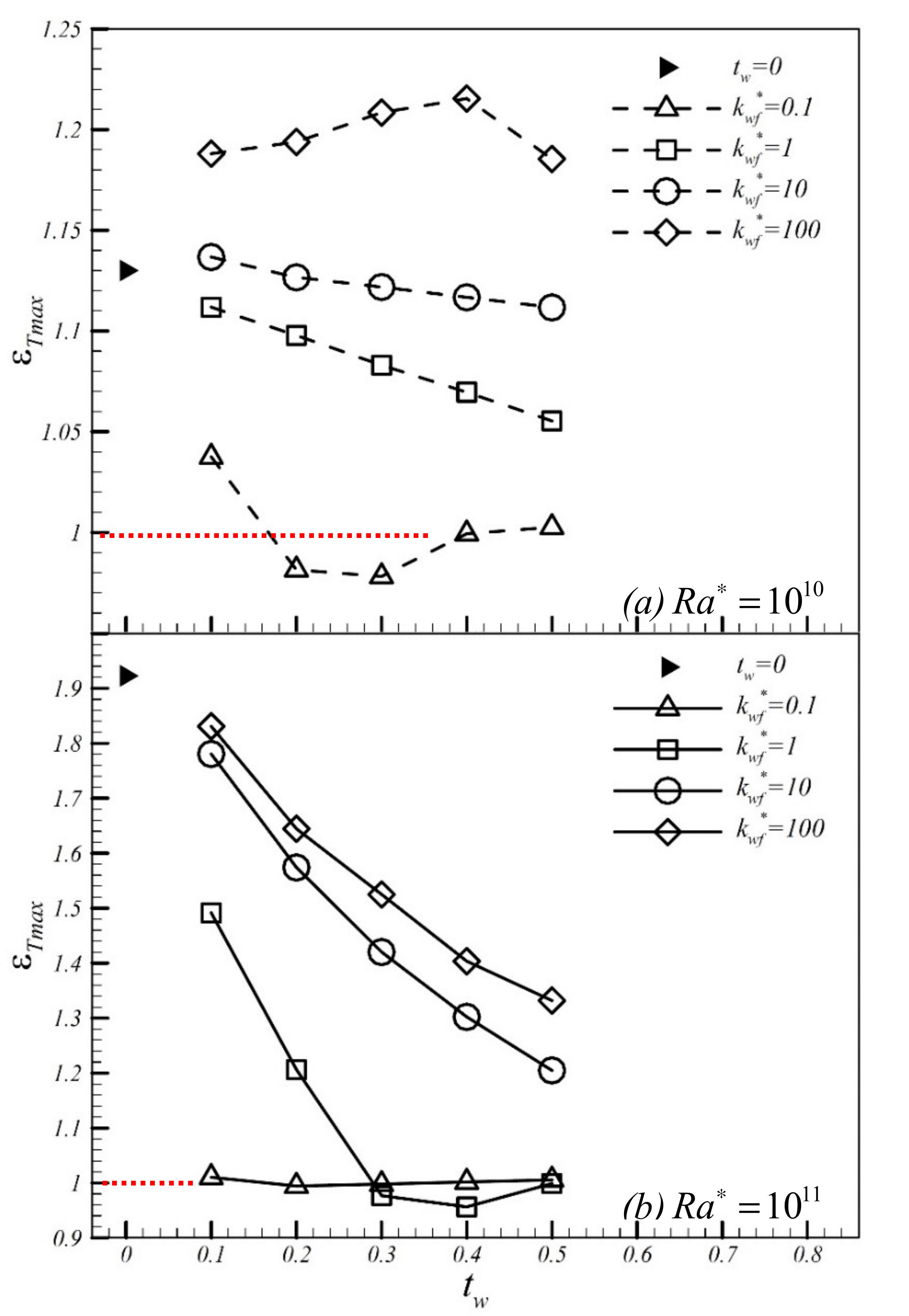
© 2020 by the authors. Licensee MDPI, Basel, Switzerland. This article is an open access article distributed under the terms and conditions of the Creative Commons Attribution (CC BY) license (http://creativecommons.org/licenses/by/4.0/).
Share and Cite
Ho, C.-J.; Lin, S.-M.; Chen, R.-H.; Lai, C.-M. Effects of Wall Properties on Temperature-Control Effectiveness of Heating Section in a Thermosiphon Containing PCM Suspensions. Appl. Sci. 2020, 10, 6211. https://doi.org/10.3390/app10186211
Ho C-J, Lin S-M, Chen R-H, Lai C-M. Effects of Wall Properties on Temperature-Control Effectiveness of Heating Section in a Thermosiphon Containing PCM Suspensions. Applied Sciences. 2020; 10(18):6211. https://doi.org/10.3390/app10186211
Chicago/Turabian StyleHo, Ching-Jenq, Shih-Ming Lin, Rong-Horng Chen, and Chi-Ming Lai. 2020. "Effects of Wall Properties on Temperature-Control Effectiveness of Heating Section in a Thermosiphon Containing PCM Suspensions" Applied Sciences 10, no. 18: 6211. https://doi.org/10.3390/app10186211
APA StyleHo, C.-J., Lin, S.-M., Chen, R.-H., & Lai, C.-M. (2020). Effects of Wall Properties on Temperature-Control Effectiveness of Heating Section in a Thermosiphon Containing PCM Suspensions. Applied Sciences, 10(18), 6211. https://doi.org/10.3390/app10186211






